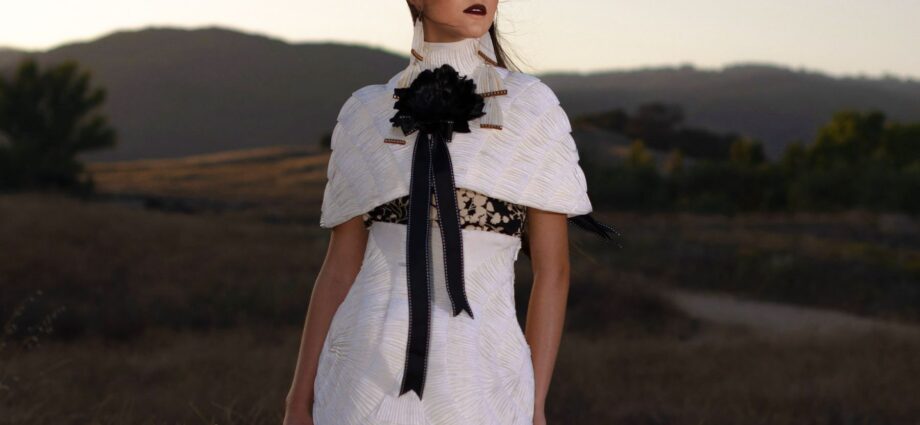This weekend, the 2025 Santa Fe Indian Market kicked off in New Mexico—a one-of-a-kind event from SWAIA that remains one of the capital city’s main attractions. The annual market, which is now in its 103rd year, gathers Indigenous artists across North America, all of whom come to sell and display their authentic, handcrafted works.
Early Saturday morning, as over 1,000 vendors set up their outdoors booths surrounding the main plaza, you could already find an impressive roster of artists from different regions, tribes, and mediums (including jewelry, fine art, pottery, textiles, and more). As usual, gaggles of serious fashion and art collectors—many of whom traverse the globe to attend the market every year—were already lined up at their favorite artists’ booths well before the sun even rose, ready to score that special piece. (For those who have yet to attend, this is no quaint little farmer’s market: Some pieces from established artists can go for upwards of $50,000.)
Prime shopping opportunities, however, were not all that this year’s Indian Market had to offer. From the kick-off gala with a runway presentation from veteran Taos Pueblo designer Patricia Michaels to the annual Indigenous Fashion Show—featuring new couture collections from buzzy designers like Jamie Okuma and Jontay Kahm—there was plenty of style to take in. Uniting all of these events? A sense of excellence and cultural innovation that proved Indigenous design is not only well and alive, but thriving.
Below, read on for the highlights from this year’s Santa Fe Indian Market.
Best of Class
Kicking off the 2025 Santa Fe Indian Market on Friday was the annual Best of Classification Awards, where Indigenous artists submit new works displaying their masterful craftsmanship. The competition was held across categories such as beadwork and quillwork, jewelry, pottery, sculpture, textiles, and more. Highlights from this year’s entries included the Best of Show winner (the top award), the Chickasaw artist Regina Free, who created a mixed-media 3-D bison sculpture made of foam, felt, paper towels, plaster, and other materials. Blackfeet Nation artist Jackie Bread won the Best of Beadwork and Quillwork category for their intricate beaded bag, while San Felipe Pueblo artist Janalee Valencia also won the top jewelry award for a striking reversible mosaic inlay necklace.
Kick-off Gala
On Saturday evening, the annual SWAIA gala gathered a well-dressed crowd. Both silent and live auctions were held, with proceeds directly benefitting the SWAIA organization’s mission to uplift and invest in Native artists through their year-round programming. Veteran designer Patricia Michaels, who once starred in a season of Project Runway, also debuted a new collection of pieces—many of her elegant creations incorporating her signature use of prints. Actor Tantoo Cardinal and former Secretary of the Interior Deb Haaland made surprise cameos on the catwalk.
Market booths
Across Saturday and Sunday, over 1,000 artists—from over 200 tribes—posted up at the Santa Fe Plaza to sell and display their new works for public consumption. The (overwhelming, in a good way) assortment included everything from pottery and fine art to textiles, jewelry, and more. The variety of craftsmanship and mediums found within these booths is what continues to draw thousands of visitors to Indian Market each year.
Within booths were hand-crafted designs that struck the balance between tradition and modernity. Artists such as Navajo jeweler Marvin Slim made use of colorful natural shells and gemstones, crafting them into sterling-silver rings. Kiowa jeweler Keri Ataumbi debuted a new assortment of her sleek silver and gold earrings and rings. Duo Sean Snyder and Adrian Stevens debuted another one of their hand-beaded “Birkin” bags (made to the exact specifications of the real thing).
Regalia Showcase
The annual Native American Regalia Showcase remains at the heart of Indian Market. Existing long before the annual Indigenous Fashion Show, the showcase features Indigenous artists in their finest regalia (typically, hand-made ensembles and pieces that are traditionally-made, and reserved for special ceremonies or powwows). This year, eight participants—from youth to elders—took to the plaza stage to discuss the origins, materials, and meanings behind their distinctive outfits. Not only were they strikingly beautiful, but their regalia shined as true storytelling at its finest.
Fashion Show
One of the most exciting and well-attended Indian Market events, meanwhile, was the concluding Indigenous Fashion Show. This year, five leading Indigenous designers took to the Santa Fe Convention Center to display their new collections for the cheering crowd: Talents included Jamie Okuma, Penny Singer, Osamuskwasis Roan, Lauren Good Day, and Jontay Kahm.
Kicking off the show was Jamie Okuma, who showed her new array of refined dresses and separates in her signature original prints. She opened the presentation with the dancer Kellen Trenal, who sported her vest and trousers in addition to his own pieces; Her show-stopping finale number, was a sculptural gown made of dentalium shells—a natural material that, for many Indigenous folks, is just as precious as diamonds. Following Okuma was the Navajo designer Penny Singer, who debuted her latest assortment of hand-appliquéd capes, vests, and colorful ribbon shirts for men.
Osamuskwasis Roan, a Cree and Dene designer who is well known around the powwow world, showcased a vibrant and colorful array of floral-print pieces and ribbon skirts; she also opened her show with a trio of traditional jingle dress dancers. Lauren Good Day, meanwhile, unveiled her new Herd collection, featuring her signature dresses, jackets, and jeans in new bison-inspired graphic prints. (Not to be missed, was her hand-painted bison hide in one of the looks.)
Rising Indigenous fashion star Jontay Kahm closed out the show. The Plains Cree designer, who just graduated from Parsons, continued with his recurring use of ribbons and feathers—this time draping colorful ribbons in avant-garde silhouettes that were reminiscent of Lady Gaga and Alexander McQueen looks (two of his biggest muses). “I wanted to take the tradition ribbon skirt and revive it in brand new ways,” Kahm said backstage. Mission accomplished.

